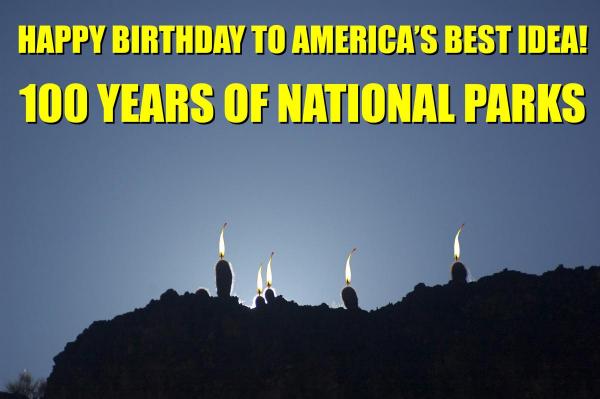
One hundred years ago today, Woodrow Wilson signed into law the National Park Service Organic Act, organizing the management of the existing parks, monuments, and other protected federal lands under a single body, and granting that new body the authority and responsibility “to conserve the scenery and the natural and historic objects and the wildlife therein and to provide for the enjoyment of the same in such manner and by such means as will leave them unimpaired for the enjoyment of future generations.”
It was a bold and novel move. While a few parks (beginning with Yellowstone in 1872) had been set aside under the authority of the Secretary of the Interior, and other lands placed under the protection of the Army, most of America’s protected wild lands were under the authority of the Department of Agriculture’s Forest Service. As one might imagine, that jurisdiction meant that the national forests and wildlife reservations were managed for multiple uses, including scenic enjoyment and wildlife preservation, but also for logging, mining, ranching, and other uses that tend to degrade the wilderness. Even when the lands were managed for use by wildlife, the effects could be dire, as when predators were eliminated in hopes of boosting populations of game for human hunters. It was an extension of the way that kings had once set aside hunting preserves, and how the traditional commons was managed.
National parks represented a different way of thinking about the relationship of people to nature, and of government to wild land. It was an acknowledgment that nature exists as an end unto itself, and a recognition that the scope of human activity had grown so vast that untrammeled nature needed protection.
In the era of climate change, that charge is even more important and even more challenging. As Glenn Branch and I discussed in a webinar with the National Park Service a few weeks ago, no national park is untouched by the effects of climate change. Most famously, the namesakes of Glacier National Park are disappearing. But Yosemite and its surrounding forest, for example, are ravaged by ever more wildfires. And warmer winters are leaving forests in many parks at greater risk from beetles, denuding the forests and placing the parks at greater fire risk. Such threats are ubiquitous, and pose both a practical and philosophical challenge to the future of the parks.
As Glenn and I pointed out, the parks are also exceptional teaching opportunities. NCSE’s Grand Canyon trip, and the scholarships which NCSE members help fund, treat the Grand Canyon as the world’s greatest geology lab, as well as a place to explore ecological life zones and the nature of science itself. One of last year’s scholarship winners, Crystal Davis, finds that 90% of her students (from a low-income city in Los Angeles County, California) have never visited a national park, and so makes an effort to take field trips to expose them to the wonders of the natural world.
The parks have also been a boon to science, in ways that their founders surely never envisioned. Yellowstone was set aside in 1872 not because of its remarkable wildlife, but because of its remarkable geothermal features and the enormous Grand Canyon of the Yellowstone. Similarly, the Grand Tetons to Yellowstone’s south were set aside to preserve their remarkable vistas, and Glacier (to Yellowstone’s north) was protected so people could see mountains capped by, well, glaciers. But after a century of subsequent development, those parks (and surrounding designated wilderness areas, national forests, and various state parks) have created a massive swath of protected habitat, one of the largest intact temperate ecosystems on Earth. A review of species lists from various national parks found that the Greater Yellowstone Ecosystem had lost only one species since the 19th century, and the subsequent successful reintroduction of gray wolves has corrected even that deficit. Being able to study a virtually intact ecosystem has been invaluable to ecologists, conservation biologists, and to ethnobotanists and anthropologists trying to understand life in western North America before white settlement.
Yellowstone also, famously, contributed a building block for modern molecular biology. Bacteria from Yellowstone’s famous hot springs offered a solution to one of the great challenges in the early days of DNA sequencing, yielding an enzyme capable of replicating DNA at high temperatures. Researchers needed to heat up DNA samples to unravel the DNA before amplifying it, and the enzymes that do the job of copying DNA in most critters just couldn’t stand the heat. But Thermus aquaticus lives in near-boiling water all the time, so researchers predicted (rightly) that its enzymes would handle the task just fine. The growth of DNA sequencing for research, forensics, and personal interest since then is all thanks (in part) to the prescience of Ulysses Grant for creating Yellowstone, Woodrow Wilson for organizing the Park Service to protect it, and subsequent generations of leaders for upholding these vital parts of our national identity, what Wallace Stegner rightly called “the best idea we ever had.”

